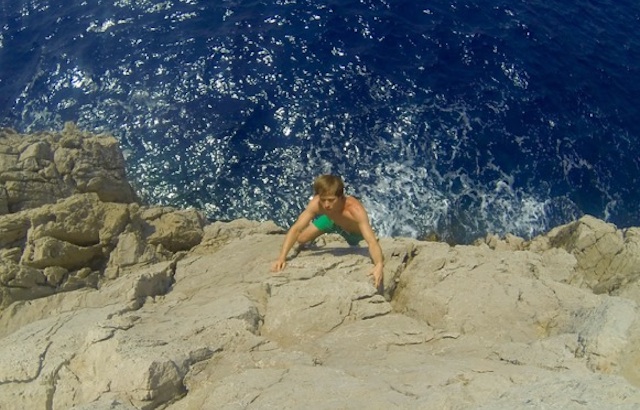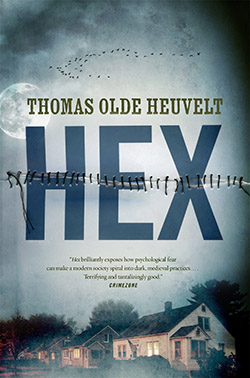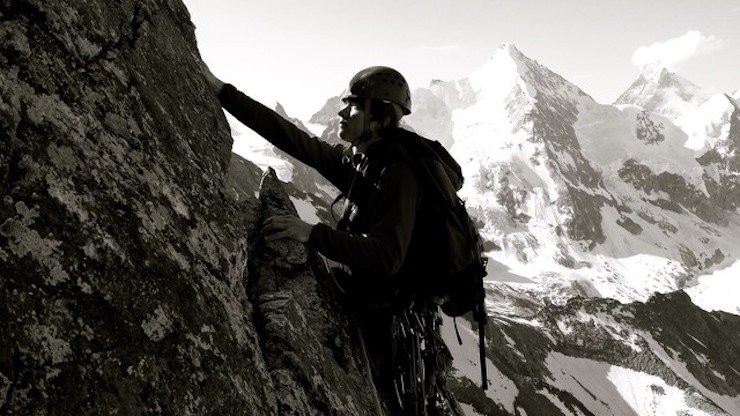In this ongoing series, we ask SF/F authors to describe a specialty in their lives that has nothing (or very little) to do with writing. Join us as we discover what draws authors to their various hobbies, how they fit into their daily lives, and how and they inform the author’s literary identity!
I write scary books, so I like my scares and frights. But sometimes, I have to admit, I overdo it a little. If you ever read a scary book or watched a horror movie and you’re so tangled up in it that it grabs you by the throat, you probably recognize the moment when you’re like, Why am I doing this again? What was I actually thinking?
Imagine you’re in Switzerland. You’re me, so you’ve just climbed this incredibly spectacular-looking peak called Zinalrothorn, which towers like a ruined castle thousands and thousands of feet over its surrounding glaciers. This is one of those that has no easy way down. The escape route is the knife-edged north ridge, a harrowingly steep descent over cruxes called the Sphinx, the Razor and Le Bourrique. These names send chills down your spine.
Le Bourrique means “donkey’s back.” I like donkeys. But I don’t like Le Bourrique. It’s a 150 feet horizontal traverse, which is so narrow that you have to sit with your right leg in the eastern basin, and with your left leg in the western basin. Like you’re riding a donkey. Both sides go straight down. Of course you know that famous black-and-white picture of the Empire State Building construction workers. You know, the one in which they’re lazily smoking a cigarette and dazing in the sun on a beam nine hundred feet up in the air. This is like it, except below us is no 1930s New York. Below us, on either side, is a three thousand feet drop of nothing.
So we’re halfway, my buddy Pieter and I, facing each other, secured to a rock. Riding the donkey. Feet dangling down vertical cliffs on each side. Pieter sorts out the rope and matter-of-factly looks down into the eastern basin. And then his head rolls off.
You’ve heard about how most deadly mountaineering accidents happen on the way down, right? The climber has reached the summit, fails to realize they’re only halfway, and loses focus. It’s one of the most notorious dangers that comes with the trait: you have to remain absolutely focused on every step and every movement until you’re all the way down in the valley.
It’s not really Pieter’s head that disappears in the depths; it’s his helmet. Back on the summit, he took it off, and as he put it on again, he forgot to strap it. It’s one of these little things that are an alarming sign of summit happiness and loss of focus.
It sure looked like his head though, for a moment. Utterly baffled and in silence, we both stare it down as it falls away from us, a little red dot getting smaller and smaller. It’s not hard to imagine what it would look like had there been a person attached to it. I imagine flailing arms and legs. And I imagine total silence. No screaming, no harrowing cry. That’s the scariest part.
You know. Why am I doing this again? What was I actually thinking?
There are many times in a mountaineer’s life when these questions come back to haunt you. At least, in mine there have been …
The time we were climbing an ice face on Piz Bernina in eastern Switzerland and a huge hanging glacier came avalanching down a mountain face behind us, half a mile away, covering our tracks on the glacier where we had just been thirty minutes ago.
The time a thunderstorm hit us on a remote peak called La Grivola in northern Italy, and our metal climbing gear started buzzing because of the mounting electricity in the air, turning us into human lightning conductors.
Or the time this boulder the size of a flat car came speeding down the snow slope, right for our rope group, and we could just lift the rope between us in time for it to flash by underneath, instead of ripping us all off our feet and dragging us down the mountain.
Why am I doing this again? What was I actually thinking? These are serious questions that one should think about when you pertain in a hobby that can go from scary to deadly with a single stupid decision or moment of carelessness. I mean, the whole idea about thrillseeking in horror books and movies, and even in rollercoasters rides, is that you cannot get hurt and hence enjoy the situation, right?
My boyfriend sure doesn’t like me climbing. He’s the kind who likes cities. Art. Beaches. Even nature—but not to the extent I tend to overdo it. I wonder if you can really explain your reasons to someone who doesn’t climb mountains. There’s a seemingly irreconcilable chasm between the idea of putting one’s life at stake for something as senseless as climbing a dirty pile of rocks and ice … and the notion of moving through a floating landscape, a motion in uttermost concentration in which you have full control over the essential balance that keeps you alive, and therefore makes you feel alive. Crossing that chasm is the toughest climb in the life of any mountaineer in a relationship. Make that any human being in a relationship, now that I think of it.
But there’s more to it. I’m not a religious person. I don’t believe in a God. I don’t believe in faith, or in omens, or in the ghosts and witches that haunt my books. But I do believe some places have power, or souls if you will. Mountains are such places. Gurus, monks, and prophets came down the mountains and interpreted their power as revelations of the divine, but you don’t have to be a spiritual messenger to feel the life in rock and ice. As a mountaineer, you feel it every single time.
The life of a mountain mimics our own, in which the years pass like our heartbeats. They’re born in a geological lovemaking when continents collide, raise to the sunlight and, just like we do, pass through a youth of splendor and expectation. Seemingly untouchable, they endure the pulse of time, breathing in the eternal cycle of frost and thaw. They witness the wonders of ice ages and the passage of the galaxy. Only when the continents come to a rest, the mountain reaches its middle age and its persistence against the elements starts to crumble. Yet it still takes millions and millions of years before they collapse in old age into softer sloping, greener hills, carved out by slow meandering rivers. End then, at the end of its life, the mountain is laid to rest in sea, until the cycle starts again.
When I am on a mountain summit, I can experience the full extent of this life. The meaning of birth, life, and death over this unimaginable, unmeasurable space of time, and I put my own life against it like a pebble in the palm of my hand. This experience is purely overwhelming. It’s exhilarating and terrifying and transcending and life-changing at the same time.
It is also the sole moment in my life that my mind is completely empty. For a mind as full and imaginative and disturbed as my own, this is quite a relief. When I come down a mountain, I feel completely recharged.
There are, however, these moments that you reconsider, when things get a little out of hand, or death slips right past you. I have a novel coming out in countries all around the world, and that’s special enough that I’d like to live to actually see it. I have a zillion of other novels in my mind—the next one is about the soul in mountains, by the way, and it is scary, I can promise you that—and I would still like to be there to write them. And I have a boyfriend whom I love very much.
So I’ve lowered my goals. I still climb mountains, but I don’t do the extreme stuff anymore. You and I probably have a different definition of extreme, but you’ll have to believe me when I say that I have eased up a bit. It’s quiet enjoyable to read a scary book without you in it, or to go to the theaters to watch a horror movie and walk out alive. Climbing with a safety-net underneath, so to speak.

So nowadays you can find me more and more climbing in the Mediterranean. Empty mind, sun on my back, and if you fall, it’s the good kind of wet splash.
It still has a catch, though. I never want to fall.
I’m terribly afraid of sharks.
Thomas Olde Heuvelt is a Hugo Award-winning novelist and short story author from The Netherlands. His horror novel HEX will be published this month by Tor in the United States and Canada, and by Hodder & Stoughton in the UK and Australia. It’s been sold to publishers in countries around the globe, including China, France, Brazil and Turkey. Warner Bros. is currently developing a TV series based on the book. Besides being a writer, Olde Heuvelt is an avid mountaineer. Find him on Twitter @Thomas_Novelist.
is a Hugo Award-winning novelist and short story author from The Netherlands. His horror novel HEX will be published this month by Tor in the United States and Canada, and by Hodder & Stoughton in the UK and Australia. It’s been sold to publishers in countries around the globe, including China, France, Brazil and Turkey. Warner Bros. is currently developing a TV series based on the book. Besides being a writer, Olde Heuvelt is an avid mountaineer. Find him on Twitter @Thomas_Novelist.










